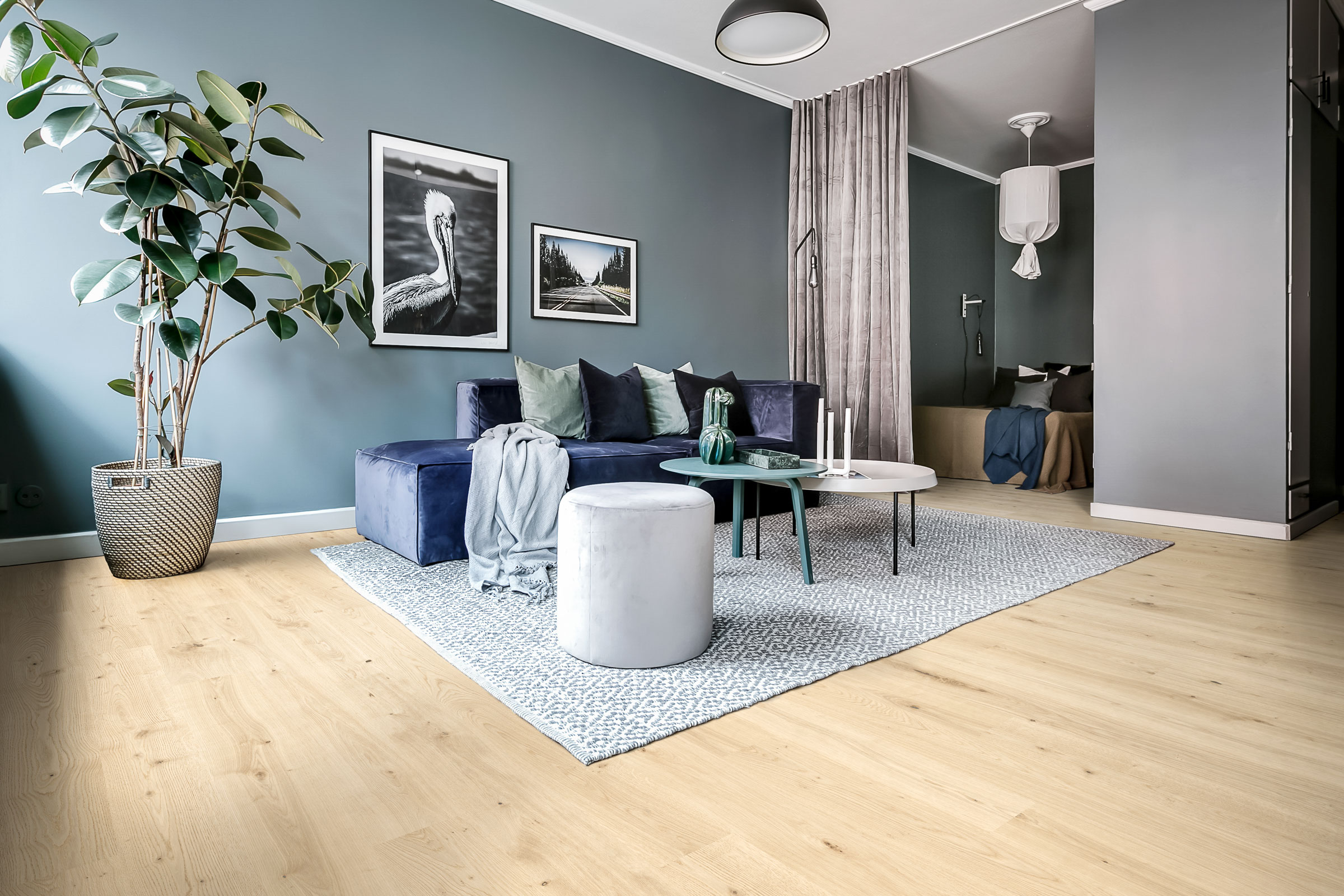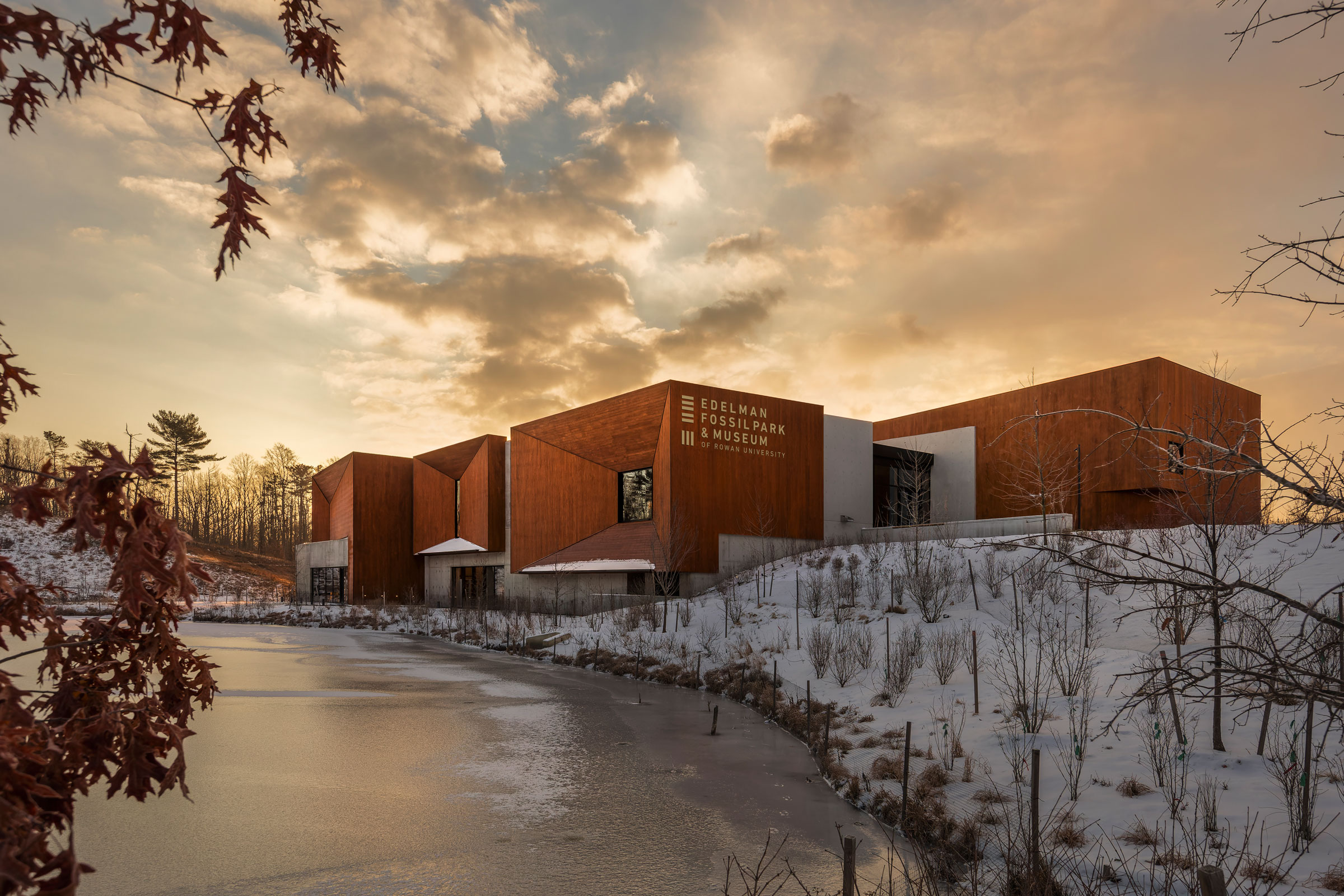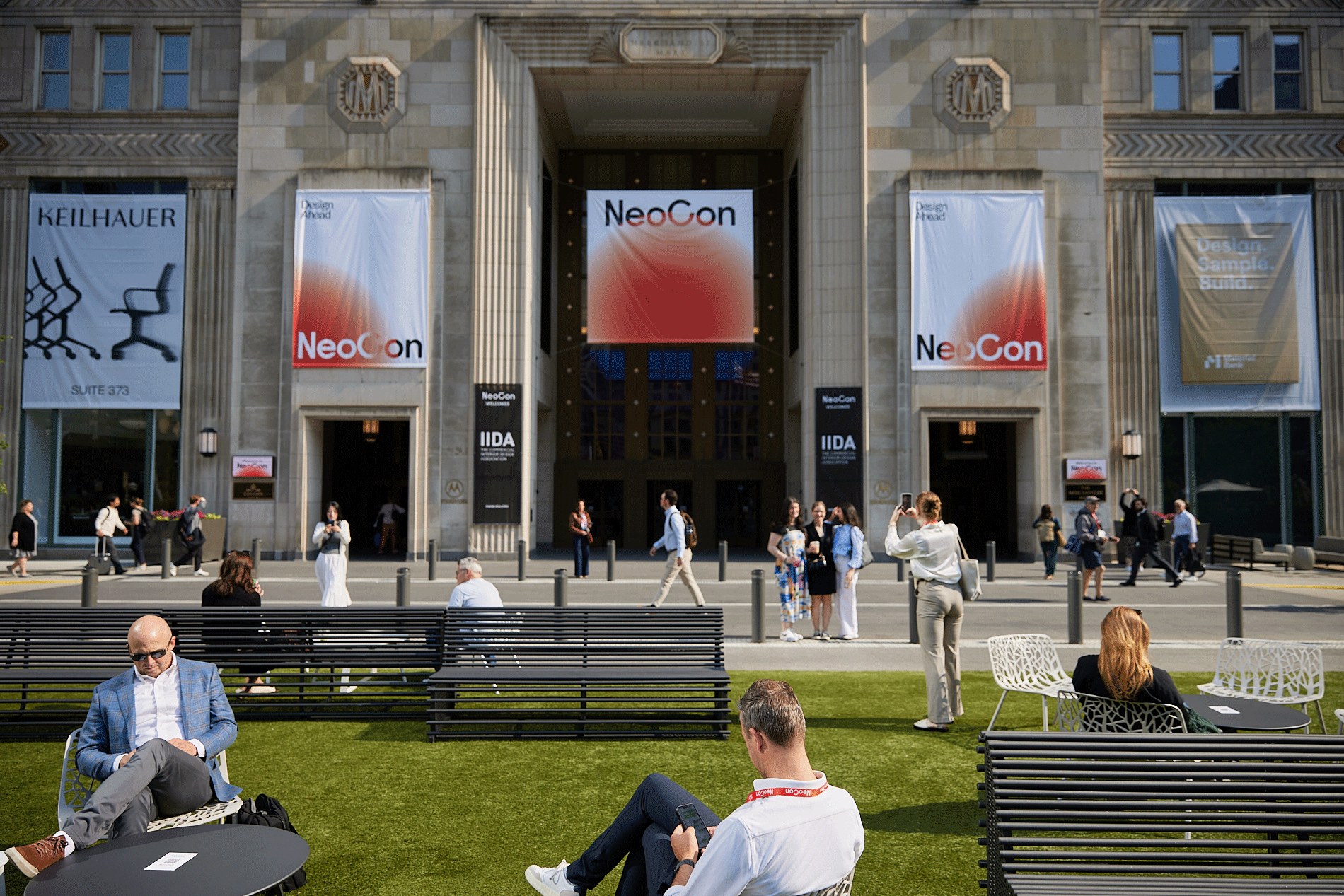Story at a glance:
- Flooring and sustainable flooring materials are expected to rise at a CAGR of 5.1% between 2021 and 2031.
- Sustainable flooring can range from hardwood to rubber to carpet and more.
- Finishing and coatings can help keep floors clean, durable, and beautiful for years to come.
Whether your next project is a home renovation, a new school design, or a commercial or hospital remodel, sustainable flooring can elevate the space.
As the demand for eco-friendly flooring solutions increases, it’s important to understand your options. “Global flooring and carpet sales will grow at a healthy CAGR of over 5% through 2031, despite a period of muted growth in 2020,” according to a study by Future Market Insights.
The study reveals that sustainability has become more important to consumers. Sustainability is an irrefutably significant thought for designers and architects, as well as the customers they design for. Due to the waste that’s produced when installing flooring and carpet, choosing flooring responsibly is key.
Hardwood, porcelain, rubber, and even carpet can all be sustainable. This guide to sustainable flooring includes the many sustainable options and how you might use them.
What is Sustainable Flooring?
Sustainable flooring is any type of flooring that is produced using natural, low-carbon, and/or recycled materials and that has a low environmental impact over the course of its lifespan. In practice this starts with how the flooring’s materials are collected and ends with how the material is disposed of.
Sustainable flooring should use renewable materials capable of being harvested with minimal emissions and that can be easily recycled, repurposed, or are biodegradable.
It’s also important to consider the manufacturing process behind a product when evaluating if it’s truly sustainable. Does the manufacturer source their materials ethically? Do they recycle waste of the products they make? Do they use renewable energy to produce those products?
These are the things to consider when deciding whether or not a flooring can actually be described as sustainable.
Types of Sustainable Flooring
When people hear the words “sustainable flooring,” they typically envision one of two materials: timber or stone—and while it’s true that these (alongside dirt) are some of the oldest options, they are by no means the only choices when it comes to sustainable flooring.
Hardwood

Hardwood flooring made from ethically-sourced timber that comes from responsibly-managed forests is one of the most sustainable flooring options there is. Photo courtesy of Bona
Hardwood is a natural material that supports a circular economy. A circular economy means designing to reduce waste by elongating the life of existing products and materials. Wood is an ideal choice for a circular economy because it can easily be reused and recycled at the end of its life in a given built environment. Recycled hardwood flooring is just one example of this. Sustainably speaking, refinishing hardwood flooring surfaces can reduce the carbon footprint by more than 75% compared to floor replacement, according to a recent report from Bona.
The global hardwood flooring market is expected to reach $61.78 billion by 2028 and register a revenue CAGR of 4.3% over the forecast period, according to the latest report by Reports and Data.
Responsible sourcing and manufacturing can be seen across the hardwood flooring industry. Delta Millworks is one hardwood manufacturer that is taking sustainable sourcing seriously. “We source sustainable wood out of tree farms in New Zealand or British Columbia, where they’re pulling out less than 1% of the standing trees every year and then regrowing them, so most forests there are expanding,” Robbie Davis, Delta Millworks CEO, previously told gb&d. “We don’t touch tropical hardwoods coming out of the Brazilian rainforest. And there’s still some clear-cutting going on in Asia and Africa and other parts of the world, so we avoid those, too. Frankly, we think modified woods like Accoya, our most popular product, outperform them. It’s Radiata pine that takes about 28 years before it’s ready for harvest.”
Pros of Hardwood Flooring
- Varied design options. Due to the fact that it is available in a multitude of species, varnishes, stains, and grains, hardwood flooring is a timeless design option that is capable of complementing just about any architectural style.
- Easy to install. Compared to something like polished concrete or stone, hardwood flooring is fairly simple and quick to install, which helps reduce overall construction time and emissions.
- Durable. While it may not be as durable as, say, porcelain tile, hardwood is nevertheless a strong, sturdy material that can last for well over fifty years with proper maintenance and semi-regular refinishing.
Cons of Hardwood Flooring
- Water damage. If there’s one thing hardwood won’t stand up to, it’s water; due to its porous nature, hardwood soaks up any water that spills or leaks in, which can lead to staining, warping, buckling, and even rot.
- Susceptible to termites. As is the case for most non-engineered wood products, hardwood flooring is susceptible to attacks by termites; if the damages incurred are severe enough, they can jeopardize the structural integrity of the flooring.
- Can be expensive. On average, hardwood floors cost between $6 and $18 per square foot to purchase and install, which is pricier than, say, laminate or vinyl; exotic wood species and certain grain patterns can further increase the overall expense.
Eco-Friendly Carpet
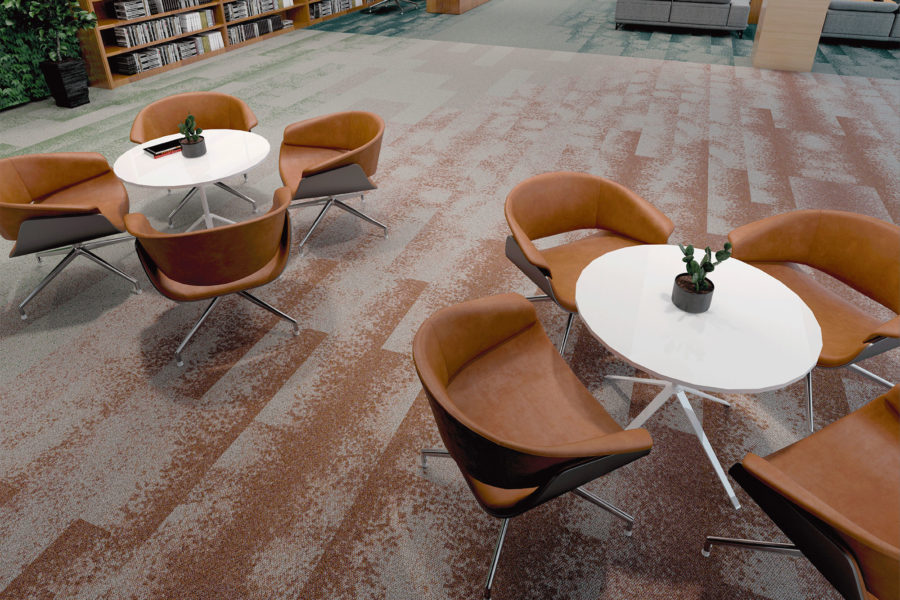
Aquafil’s ECONYL regenerated nylon fiber yarn is made from 100% recycled waste. Photo courtesy of Aquafil
Carpets hold a 60% share of the US flooring market, with 19 billion square feet sold per year. The EPA estimates that about 5 billion pounds of carpet are discarded in landfills in the US every year. Most carpets are made primarily from finite resources in the form of oil-based plastics that could be recycled.
Carpet is known to be primarily made from oil-based plastics, but not all carpet has to be made this way. One way you can make more sustainable choices when it comes to carpet is by making sure existing carpet is recyclable.
At Aquafil USA, old carpets are collected and disassembled to create ECONYL® regenerated nylon fibers and pellets. “ECONYL is made from 100% waste instead of oil. For every 10,000 tons of ECONYL raw material, 70,000 barrels of crude oil are saved, and 65,1000 tons of CO2 equivalent emissions are avoided. Using ECONYL yarn offers up to 90% reduction in global warming potential compared to nylon from fossil sources,” Franco Rossi, president of Aquafil USA, previously wrote for gb&d.
This material is then used by more than 2,000 brands around the world to create the next generation of sustainable carpets as well as clothing, chairs, handbags, sneakers, sunglasses, and tables.
Pros of Eco-Friendly Carpet
- Energy-efficient. Due to their thickness and insulating qualities, carpeted floors can help keep buildings warmer in cold weather, which helps reduce heating loads and improves energy efficiency.
- Comfortable. Carpeted floors are one of the more comfortable flooring options out there, both in terms of walking on and in the sense that they often make a room more inviting.
- Sound-dampening. As a soft material, carpet helps absorb and dampen sound—a feature that may be ideal in shared apartment spaces and large residential complexes where voices, music, and footsteps are commonplace.
Cons of Eco-Friendly Carpet
- High maintenance. As with any carpet or rug, eco-friendly carpets require more maintenance and cleaning than other types of flooring; they require frequent vacuuming to remove trapped dirt and regular professional cleaning to remove embedded dirt.
- Shorter lifespan. Even high-quality carpet made from natural and recycled materials has a much shorter lifespan (between 5 and 20 years) than most other types of flooring materials, which means it will need to be replaced more frequently.
- Retains moisture. Unless you install wool carpet or some other moisture-resistant carpet type, your carpeted floors won’t be able to handle spills or leaks well, as carpet easily retains moisture; if left unchecked, this can lead to mold/mildew growth or rotting below the carpet.
Recycled Rubber
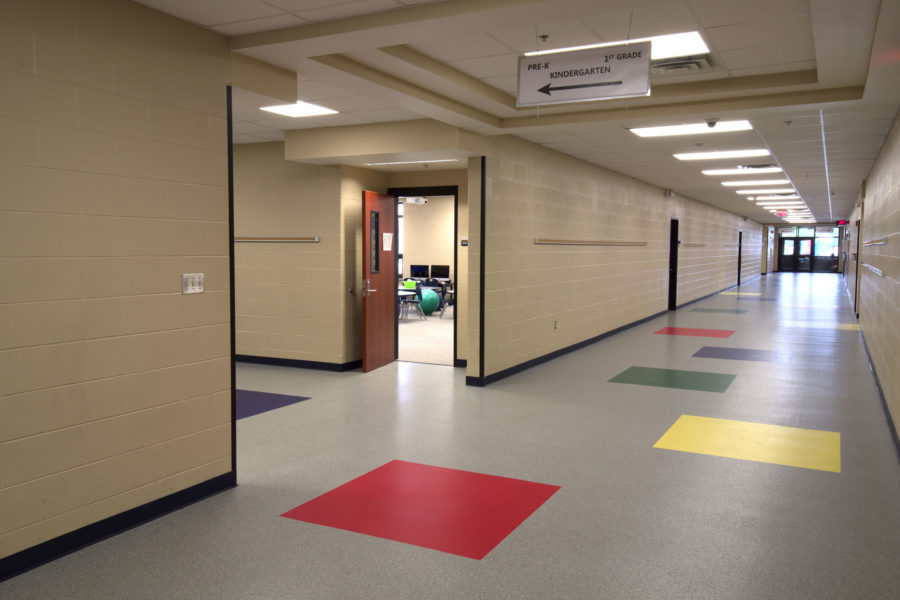
REGUPOL’s sustainable rubber flooring is used in Arbor Grove Elementary in Oklahoma City. Photo courtesy of REGUPOL
Rubber ranks as a sustainable material for flooring because of its durability, capacity to be recycled, and low maintenance. Rubber is an ideal flooring option for high traffic buildings such as schools and health care facilities. Adding recycled rubber flooring to these types of projects helps bring public spaces one step closer to sustainability.
Made of 100% post-consumer tire and post-industrial EPDM rubber, REGUPOL Revolution is inherently slip-resistant, durable, and comfortable underfoot. This rubber flooring is ideal for schools and hospitals because of its noise reducing capabilities. “Commercial rubber flooring like Revolution is known for its sound-absorbent qualities and proven effectiveness in minimizing sounds associated with echoes in the hallway and heavy foot traffic to a more tolerable, less distracting level,” Wil Younger, marketing manager at REGUPOL, previously told gb&d.
REGUPOL’s products can also help architects and designers earn points in two out of five LEED categories—Materials and Resources and Indoor Environmental Quality.
Pros of Recycled Rubber Flooring
- Slip resistant. Rubber has a naturally high coefficient of friction, which means it provides excellent traction and is fairly slip-resistant, reducing the probability of falls and other potentially dangerous accidents.
- Absorbs impact. Due to its elastic molecular structure, rubber flooring is exceptionally good at absorbing impacts without damage, making it ideal for gyms and high foot traffic areas.
- Incredibly durable. Thanks to its natural elasticity and shock-absorbing qualities, rubber flooring is incredibly resilient and capable of withstanding heavy foot traffic; on average, you can expect rubber floors to last between 20 and 50 years.
Cons of Recycled Rubber Flooring
- Strong smell. Depending on the flooring, some rubber floors may give off a strong scent that some people find undesirable; the rubber smell tends to dissipate over time but can make rubber flooring an unwanted option for smaller enclosed spaces.
- May fade over time. While some rubber flooring can be made UV-resistant, many recycled rubber floors lack this quality, which can lead to fading and loss of color over time.
- Can be difficult to install. Before rubber flooring can be installed, the subfloor needs to be prepared properly to ensure the correct adhesive is used to counteract any existing slab moisture; this means rubber flooring always requires experienced professionals to install.
Linoleum
True linoleum—as opposed to synthetic vinyl linoleum—is considered to be sustainable as it is manufactured from 100% all-natural materials. Consisting of a mixture of rosins, wood flour, powdered cork, ground limestone, pigments, as well as jute and linseed oil, linoleum is fully biodegradable and will not release harmful toxins into the environment.
Traditionally linoleum is applied in sheets or tiles but linoleum is also available as a liquid. Developed in the Netherlands by Duracryl, liquid linoleum features many of the same all-natural ingredients as its solid counterpart: cork, vegetable oil, linseed oil, limestone, and a coloring agent. Liquid linoleum is mixed on-site and applied using a trowel or roller to create a uniform surface without joints or seams.
Pros of Linoleum
- Water resistant. While not completely waterproof linoleum is nevertheless incredibly water-resistant, making it an ideal option for kitchen and bathroom floors; prolonged exposure to water can, however, cause linoleum to warp and swell.
- Durable. Linoleum is inherently scratch-resistant and hides wear-and-tear well; as long as it is properly cared for linoleum flooring can conceivably go 20 to 40 years before needing to be replaced.
- Low maintenance. Aside from occasional sweeping and mopping linoleum flooring does not require intensive maintenance.
Cons of Linoleum
- Requires professional installation. To ensure it is laid down and affixed properly, it is recommended that linoleum be installed by professionals, which can increase a project’s overall costs.
- Ambering. Though it isn’t permanent, linoleum that is continuously shielded from sunlight will undergo ambering and turn darker as a result of the linseed oil in the product; once exposed to sunlight, however, the ambering will gradually disappear.
- Can be dented. While it is a long-lasting and relatively resilient flooring option, linoleum can still be dented by heavy furniture over time.
Luxury Vinyl Tile
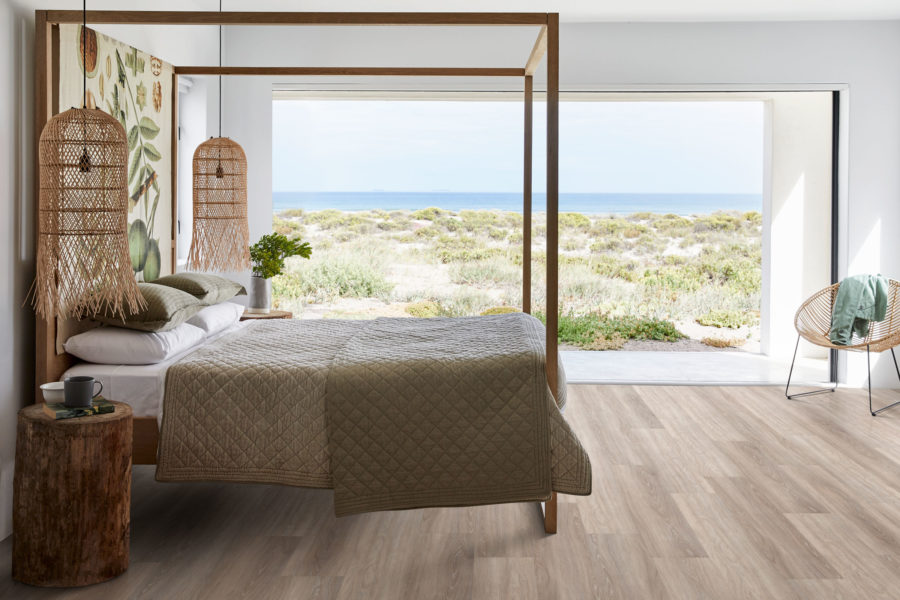
Kährs’ LVTs include glue-free Click joint options for a quick, easy install. They also come in wood, stone, and herringbone designs. Photo courtesy of Kährs
Luxury vinyl tile (LVT) is a type of flooring designed to realistically mimic the appearance of stone, wood, marble, or other natural materials. It is an ideal flooring option for those who want the look of natural materials but don’t want the high upfront costs or maintenance requirements that typically come with said materials.
“Especially for a building owner, LVT is a very easy product to put in because of its low maintenance. And it’s hard to damage,” Sean Brennan, US president of Kährs, told gb&d in a previous article. “It’s a good alternative to carpet. It’s easier to clean, it has some water-resistant features, and can be less expensive than other flooring alternatives.”
Founded in Sweden, Kährs is a leading manufacturer of engineered floors, offering a range of solutions for projects that need wood, resilient, and LVT flooring for both the commercial and residential markets. Kährs’ LVTs are all phthalate free and are offered with the option of glue-free click joints, a feature that streamlines installation and reduces VOC emissions.
Metroflor is another well-known manufacturer of low-toxicity, durable, and environmentally conscious LVT flooring solutions. Metroflor is one part of HMTX Industries, a global LVT manufacturer that’s hyper-focused on material transparency, carbon reduction, and water/energy conservation.
HMTX envisions their business model through three distinct pillars, which include design excellence, supply chain superiority, and sustainability, transparency, innovation, and quality. “We believe that resonates with the design community. We believe that resonates with millennial shoppers. And we believe sustainability and transparency leads to good quality and the ability to be innovative,” Harlan Stone, CEO of HMTX, previously told gb&d.
Pros of LVT
- Lightweight. LVT is a very lightweight product, a quality that makes it easy to handle and install.
- Low-maintenance. Once installed LVT flooring requires very little maintenance, necessitating only occasional sweeping/vacuuming and mopping.
- Water resistant. As a vinyl-based product, LVT is naturally water resistant and therefore essentially immune to moisture damage; this makes LVT an ideal flooring option for bathrooms.
Cons of LVT
- Can be scratched and dented. Despite having a fairly high durability, LVT is still susceptible to denting from heavy furniture and can be scratched or pierced by sharp objects.
- Difficult to remove. LVT flooring that is installed using glue-down or other adhesive-based methods can be difficult to remove later on.
- Discoloration. Most LVT flooring has a low tolerance for UV rays and is prone to fading/discoloration when regularly exposed to sunlight.
Polished Concrete
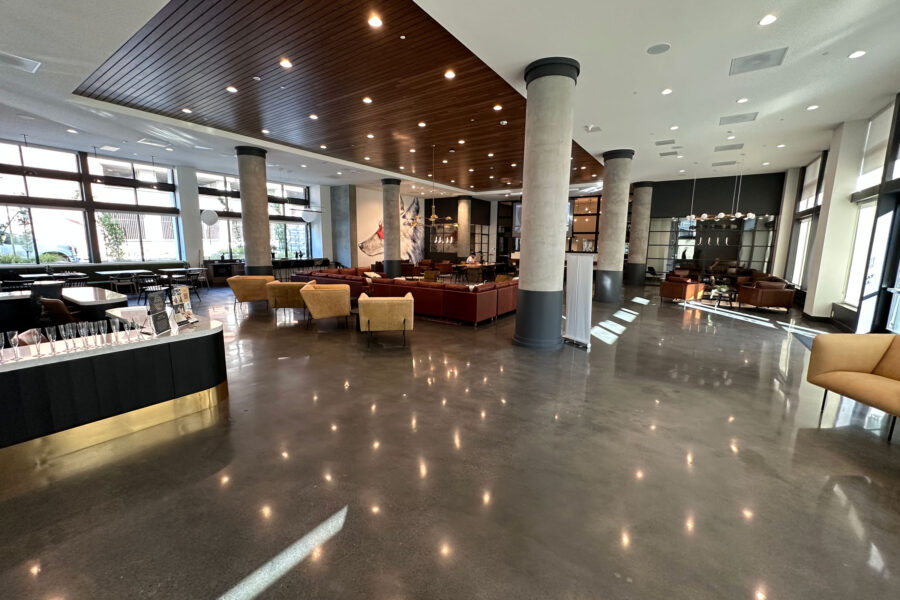
The concrete look in this restaurant provides a shiny, also mirrored feel. Photo courtesy of Westcoat
Concrete is an extremely popular flooring option, one that typically serves as the foundation upon which other types of flooring or coatings are installed. This is not, however, the case for polished concrete, which holds its own as a separate type of flooring altogether.
Achieved through mechanically grinding and honing the surface of a concrete slab using densifiers, grout materials, and guards, polished concrete takes all of the desirable qualities of concrete and ups the ante: it’s incredibly resilient, non-toxic, slip-resistant, and—thanks to its highly polished surface—even helps make efficient use of natural light.
Polished concrete can also support a wide variety of design options depending on the desired level of aggregate exposure. “In layman’s terms what you’re doing is exposing more of the aggregate as you cut deeper into the concrete; generally the size of the aggregate will increase,” Todd Cook, Westcoat’s product manager, previously told gb&d. “A light grind will get you that salt and pepper exposure whereas further into that concrete matrix you get into larger aggregates.” This customizability makes it easier to match polished concrete with a building’s existing aesthetic preferences.
Because polished concrete is very durable, low in toxic compounds, and uses material that has already been placed, it is generally considered to be an extremely sustainable flooring option.
Pros of Polished Concrete
- Extremely durable. Concrete is already a very strong substance, but the polishing process actually creates an even harder wear surface, making polished concrete resistant to scratches, scuff marks, abrasion, and many other damaging forces.
- Easy to maintain. Once installed polished concrete floors are incredibly easy to keep clean. All you have to do is vacuum or sweep every so often and clean with a damp mop once every one to two weeks.
- Low VOCs. Due to the fact that polished concrete does not require the use of sealants—of which often contain toxic chemicals—it is extremely low in VOCs, thereby improving indoor air quality.
Cons of Polished Concrete
- Uncomfortable. It should come as no surprise that polished concrete is, well, a very hard substance. In many cases this would be a plus, but it can also be hard on employees who have to stand on it for long periods of time.
- Relies on proper installation. In order for it to look right, polished concrete flooring relies heavily on the concrete slab’s initial pour; this can make it difficult to have an existing concrete floor polished if the installation of the slab itself was poor.
Porcelain Tile
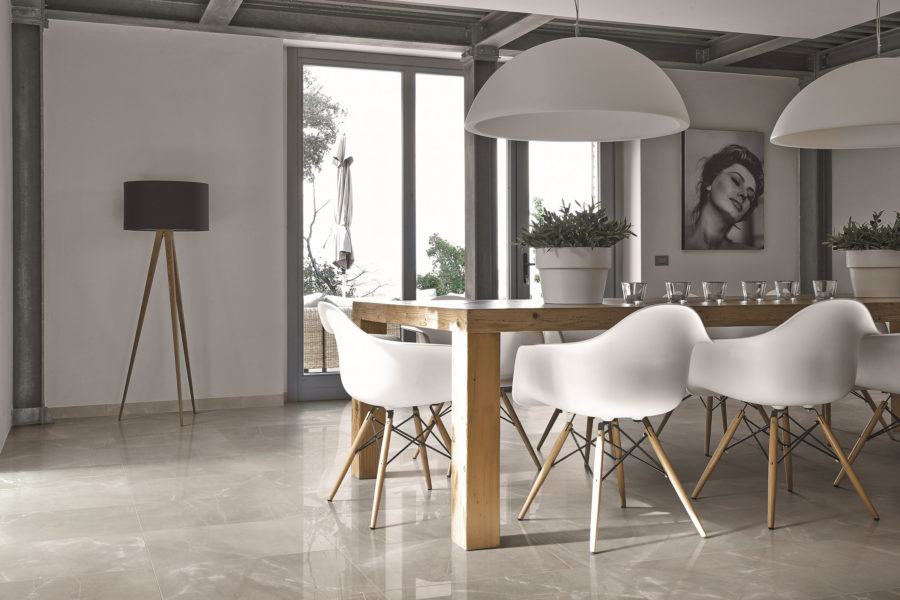
The Luxury collection comes in multiple sizes and trims and four modern colors, including Amani Grey, pictured here. Photo courtesy of Milestone
Porcelain tile is both a versatile and eco-friendly flooring solution that offers nigh-unparalleled beauty, durability, and recyclability. Typically made from abundant natural resources like clay, silica, kaolin, and feldspar, porcelain tile is fired at extremely high temperatures to create hard, dense flooring tiles with a 60 year lifespan.
This long life cycle allows them ample time to offset the emissions produced during their manufacturing—though many companies are taking steps to make the production process cleaner. “Common sustainability efforts in the manufacturing process include high scrap recycling rates, use of offsite recycled material, water reuse, and efficient use of energy (natural gas and electricity),” Don Hayes, environmental/sustainability manager for Florim USA, previously wrote for gb&dPRO.
Florim—a family-owned tile and porcelain company based in Italy—is an industry leader when it comes to sustainable porcelain. Each year the company internally recycles 99.9% of its materials and all water used during production is collected and reused in other processes. “We want a clean environment to live in. We want our products to be sustainable long-term, for us now and for our children later. It’s how we look at our business and the world around us,” writes Haynes.
Pros of Porcelain Tile
- Water resistant. Due to the fact that porcelain tile is much less porous than some other ceramics, it has a much higher resistance to liquid penetration; this makes it easy to clean up spills and helps prevent unwanted staining.
- Low maintenance. Once installed, porcelain tile flooring is pretty easy to maintain, as it only requires periodic sweeping and occasional mopping to keep it free from dirt and grime.
- Durable. Porcelain tiles are made using very fine clay that is then fired at an extremely high temperature; this process hardens and strengthens the tile, which makes it incredibly durable and long-lasting.
Cons of Porcelain Tile
- Expensive. One of the major downsides to porcelain tile flooring is its cost, both for the material itself and installation; on average a single square foot of porcelain tile costs anywhere from $14 to $63 to install.
- Grout lines. When porcelain tiles are installed, grout needs to be put down, forming grout lines between each tile; grout is a very porous material and is highly susceptible to mildew and mold if improperly sealed.
- Heavy. Like stone, porcelain tiles are very heavy; this can extend both the shipping and installation process by a considerable margin.
Bamboo
Bamboo has served as a traditional flooring material in many Southeast Asian countries for many generations, but it has only recently started gaining popularity in Europe and North America. This is largely attributed to the material’s natural beauty as well as bamboo’s extremely fast growth and maturation rate.
Unlike hardwoods that take approximately 20 years to reach maturity, bamboo reaches its full height in as little as nine months and the same culm may be harvested every three to five years. When cultivated using traditional methods bamboo requires very little supplemental watering or fertilizing and does not require the spraying of pesticides for successful growth—characteristics that sustainability-minded companies like Trinity Bamboo prioritize when sourcing their materials.
“These are largely naturalized strands of bamboo that require no irrigation or pesticides,” Tom Goodham, president of Trinity Bamboo, told gb&d in a previous interview. “Because bamboo culms are harvested and transported off the mountain by hand, the soil and ground cover is not disturbed, which reduces or eliminates human-caused soil erosion.”
Bamboo can either be cut into slats and used as is or shredded and woven back together to create strand-woven bamboo flooring—the latter of which creates a plank comparable in hardness to exotic, rainforest-grown hardwoods like teak and mahogany.
Pros of Bamboo Flooring
- Durable. High-quality bamboo flooring—and especially strand-woven bamboo flooring—typically has a durability that rivals that of most hardwoods; it is highly resistant to insect damage, can sustain minor impacts, and has an average lifespan of 20 to 50 years.
- Can be refinished. Similar to traditional hardwood flooring, bamboo flooring can be refinished multiple times, thereby extending its lifespan and reducing the frequency of full flooring replacements; this helps to reduce both the waste and carbon emissions produced by manufacturing, shipping, and installing new flooring.
- Hygienic. In its natural state, bamboo has antimicrobial properties and is largely resistant to mildew, mold, and other potential allergens; this makes bamboo flooring ideal for use in homes and other residential spaces.
Cons of Bamboo Flooring
- Susceptible to moisture. While bamboo can be engineered to be water resistant, no bamboo flooring is ever waterproof; spills, leaks, and even high ambient humidity can cause planks to cup, swell, and warp.
- Fewer design options. Unlike hardwood there aren’t a wide variety of bamboo species to choose from and most bamboo flooring—with the exception of shredded bamboo—only have horizontal and vertical grains; this can make it difficult to pair bamboo with non-contemporary architectural designs.
- Prone to scratches. Despite its durability bamboo flooring isn’t immune to being scratched, which can impact both the aesthetic value and longevity of the flooring itself; this can be mitigated in part by putting slip pads underneath furniture and retouching the floor on a semi-regular basis.
Cork
In recent years cork flooring has exploded in popularity thanks to its extremely sustainable production process. Unlike hardwood or bamboo flooring, cork flooring does not require that the entire plant be harvested—rather, the bark of cork oak trees is all that’s needed. As long as this process is done correctly, a single cork oak tree can be harvested every nine years without sustaining damage.
Harvesting cork bark is already a low-emission process and the fact that cork oak trees don’t need to be cut down means they can continue absorbing carbon from the air. “Cork has a soft look, and it is a carbon sink material,” HKS architect Allison Smith previously told gb&d. “Natural materials store carbon, so they are inherently low in embodied carbon.”
After the cork bark is harvested it is ground up, compressed into thick sheets, and baked in a kiln to form flooring tiles or planks. Once it eventually reaches the end of its life cycle, cork flooring can be recycled or composted, thereby reducing construction and demolition waste.
Pros of Cork Flooring
- Provides insulation. Due to its porous nature, cork flooring is an excellent insulator, one that both dampens sound and helps regulate temperature, which in turn helps reduce a building’s heating and cooling loads.
- Pest and mold resistant. Cork is naturally resistant to termites, mildew, and mold and the material itself is naturally hypoallergenic, making it an excellent choice for residential spaces.
- Comfortable. Thanks to its insulating properties and relative softness, cork makes for a comfortable flooring option. It doesn’t get as cold as stone or tile and provides better support for walking or standing for long periods of time.
Cons of Cork Flooring
- Higher maintenance. While cork is capable of shrugging off minor scratches and dents, it needs to be regularly resealed and varnished to prevent deterioration and breakage.
- Susceptible to humidity. Unlike hardwood, which only expands in one direction when exposed to high humidity, cork expands in all directions, which can compromise the look and integrity of the floor planks.
- UV damage. In its natural state cork is prone to yellowing and fading over time when exposed to direct sunlight; fortunately, the worst UV damage can be avoided by finishing cork flooring with a UV-resistant finish.
Terrazzo
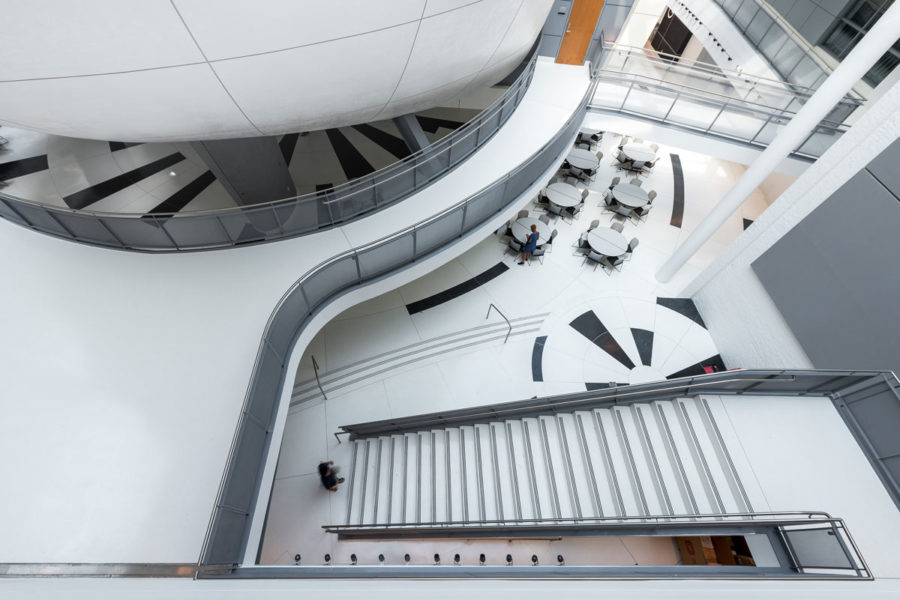
The Duke Ellington School of the Arts in DC features poured-in-place epoxy terrazzo. Photo courtesy of Terrazzo & Marble Supply Companies
While terrazzo has existed for thousands of years, today’s terrazzo takes its roots from 20th-century Italian quarrymen who combined leftover granite and marble chips with cement to pave their terraces. As a composite material terrazzo provides ample opportunity to utilize stone refuse that would otherwise be discarded.
“We take a lot of things that would be put into the waste stream that we can reclaim and reuse in a terrazzo floor,” James Bateman, terrazzo division manager of Terrazzo & Marble Supply Companies, previously told gb&d.
Today Terrazzo & Marble Supply Companies casts its terrazzo in epoxy resin instead of cement, which helps reduce VOCs—and because they make all of their epoxy themselves, Terrazzo & Marble is able to offer an even wider variety of colors and design options. “You can select any paint manufacturer’s color from their fan deck and we’ll match the epoxy to it,” Bateman says.
Many terrazzo suppliers, including Terrazzo & Marble, continue to uphold the tradition of recycling local quarry waste, which can help reduce carbon emissions incurred through the shipping process.
Pros of Terrazzo Flooring
- Long-lasting. Much like cut stone, terrazzo flooring is very durable and lasts for a long time—on average, a terrazzo floor lasts between 40 and 100 years before it needs to be replaced, with most lasting upwards of 75 years.
- Easy to clean. Once installed, terrazzo flooring requires very little maintenance and is incredibly easy to clean—all you need to do is sweep periodically and clean using soap and water to remove dirt and grime buildup.
- Customizable. Because terrazzo is a composite, there are a wide variety of aesthetically-pleasing colors, designs, and material types to choose from; marble and granite are traditional, but terrazzo can also accommodate glass, quartz, silica, and many other materials.
Cons of Terrazzo Flooring
- Expensive. One of the main disadvantages of terrazzo flooring is its upfront cost—you can generally expect to pay between $20 and $60 per square foot of terrazzo, which can seriously increase a project’s overall construction costs; these costs are typically justified, however, by terrazzo’s long lifespan.
- Difficult installation. Terrazzo has an incredibly precise installation process that requires the hiring of experienced professionals; improper installation can lead to visual defects and compromised structural integrity.
- Uncomfortable. Like stone or concrete flooring, terrazzo floors are extremely hard and can be uncomfortable to walk or stand on for long periods of time; terrazzo is also largely ineffective at retaining heat, meaning it can be quite cold during the winter months.
Stone

This neoclassical private residence in Vancouver was built with Polycor’s SAINT CLAIR Fleuri Marble from Oklahoma, fabricated and installed by Red Leaf Stone. Photo courtesy of Polycor
One of the oldest sustainable flooring options on the market is stone. Strong, durable, and aesthetically pleasing, stone floors are a hallmark of sustainable design thanks to their status as a 100% natural, low-carbon material. “Stone has an extremely low embodied carbon footprint because it was formed by the planet itself,” Hugo Vega, vice president of commercial and institutional sales at Polycor, previously told gb&d.
As long as stone is sourced ethically and efficiently, the production process is relatively low in carbon emissions and toxic chemicals, as stone just needs to be extracted, cut, and polished before it is ready for use in flooring. Companies like Polycor focus on sourcing high quality stone right here in North America, so as to ensure that it is not extracted using slave or child labor.
Add on to that the fact that stone has an extremely long lifespan and can be recycled, and it’s not hard to see why stone is touted as one of the most sustainable flooring options on the market. “Various limestones, marble, and granite have been made by nature millions of years ago and, when used in construction, will last as long as the underlying structure lasts,” Vega says.
Pros of Stone Flooring
- Extremely durable. Out of all the flooring options in this article, stone flooring is probably the most durable; on average a stone floor will last well over 100 years and can withstand heavy foot traffic with ease.
- Easy to clean. After it is installed stone flooring is very easy to keep clean. All you have to do is sweep every so often and clean with a damp mop every couple of weeks to prevent dirt and grime buildup.
- Energy efficient. Stone floors stay relatively cool year-round, which can help reduce cooling loads in summer; if a radiant heat system is installed underneath stone flooring, it can help distribute heat evenly throughout the colder months, making for a more energy efficient heating system.
Cons of Stone Flooring
- Expensive. Similar to terrazzo, stone flooring typically comes with a high price tag—depending on the type and style of stone you use, expect to pay between $8 and $50 per square foot.
- Can be chipped. Depending on the type of stone used, stone flooring can be susceptible to chips and scratches, which can detract from the visual appeal and provide a home for dirt and bacteria to gather.
Types of Floor Coatings
Sustainable coatings and epoxies for concrete floors can prevent damage, keep spaces cleaner, and even help a variety of commercial spaces earn LEED credits.
Epoxy

Epoxy flooring as seen in an architect’s office. Photo courtesy of Westcoat
One of the most common types of floor coatings is epoxy, a resinous substance that becomes extremely hard and durable as it cures. “Resinous flooring covers a wide variety of chemistries and technologies,” says Cook. “It’s well known for its durability, adhesion, and seamless nature, which is a really important aspect with regards to cleanability, antimicrobial maintenance, and you don’t have any of the grout lines or seams like you would with vinyl.”
Restaurants, breweries, and many other commercial retailers often have concrete flooring with epoxy coating because it’s relatively easy, quick, and safe to install. Westcoat is one of the leading innovators and manufactures of epoxy and other specialty coatings used in the construction and design industries.
Polyurethane
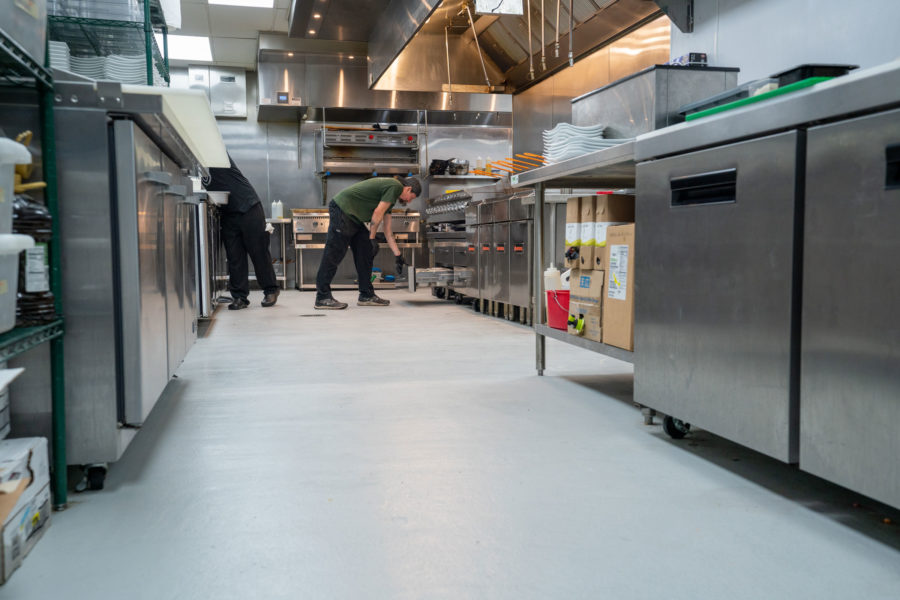
FasTop was used at Loose Ends Brewing in Centerville, Ohio. FasTop is designed for use in industrial and commercial environments like food and beverage plants, breweries, commercial kitchens, manufacturing facilities, garages, and more. Photo courtesy of Sherwin-Williams
Companies like Sherwin-Williams are a go-to resource for commercial facilities like breweries looking for the best in flooring solutions. FasTop, a family of urethane concrete systems by Sherwin Williams, is tougher and more sustainable than their chemical-heavy contemporaries. Flooring products like FasTop have become an important part of environmental certification for many commercial facilities.
Flooring solutions from Sherwin-Williams earn more points toward LEED credit for customers than any other coatings manufacturer, for everything from helping to reduce VOCs to building product disclosure and optimization, Ball told gb&d. FasTop is made with water-based components and plant-based oils, bringing natural materials more easily to the commercial environment.
Polyaspartic
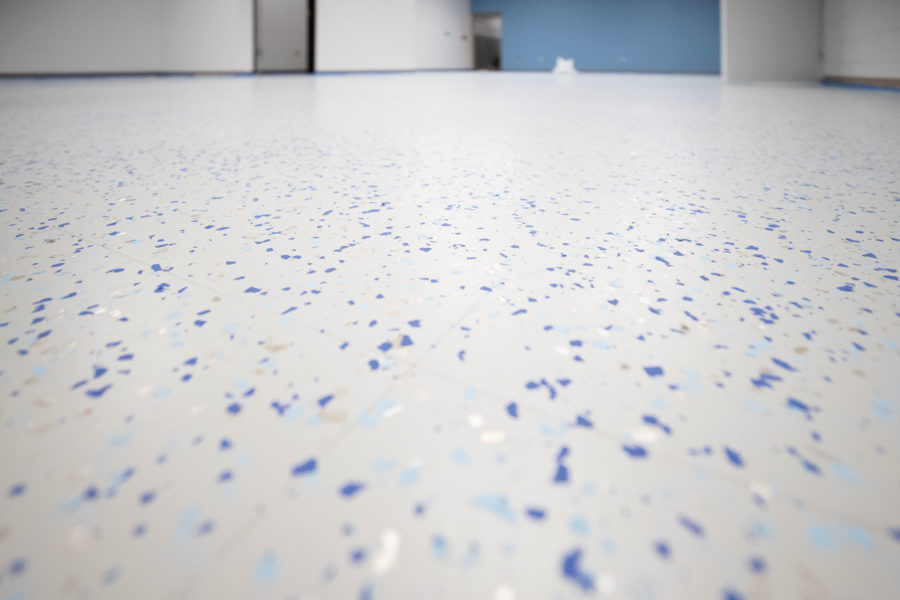
Polyaspartic floors offer increased durability while still allowing plenty of design options to choose from. Photo courtesy of Bona
Concrete floors can be coated with a polyaspartic coating, a two-part coating system that consists of both a primer/base-coat and a clear topcoat. Polyaspartic coatings are technically a subset of polyurea coatings, but they are generally considered to be even more durable than both polyurethane and epoxy coatings.
Due to the molecular composition of polyaspartic esters, polyaspartic coatings have little need for sealants—as a result, they are either low- or zero-VOC products, which in turn helps improve indoor air quality.
Another major benefit of polyaspartic coating is its wide design range—similar to epoxy, it can be pigmented in an array of colors, but polyaspartics also support flaking, or the inclusion of quartz, vinyl, or paint chips to create a speckled appearance.
Types of Floor Finishes

Bona is an industry leader in both floor care and floor renovation solutions. Photo courtesy of Bona
Once you’ve got that beautiful floor, you’ll want to maintain it. That’s where choosing eco-friendly finishes and cleaning products comes in.
For hardwood, you can choose from oil-modified polyurethane, waxes, natural penetrating oils, and acid cured, among other solutions. “But the best and most sustainable choice is always a waterborne finish, which not only offers a highly durable and long-lasting finish but is low in VOCs and overall less impactful on the environment and better for indoor air quality,” David Darche, national market manager for Bona US, wrote in a previous gb&d article.
“Additionally, waterborne finish provides a quicker cure time than many other finishes, allowing for hardwood floor refinishing projects to move along faster. Waterborne finish also allows the floor color to remain true over time as opposed to yellowing or dulling, which can happen particularly with oil-modified polyurethane finishes,” Darche writes.
Using a sealer is another step you can take to maintain clean and durable floors. A sealer will even out the surface of the wood, prevent tannin bleed and side bonding, increase durability of the floor and finish, and reduce the chance of a negative reaction between the wood and finish. Including this step can preserve, customize, or enhance a floor’s existing color.
How Can Flooring Earn LEED Points?
If you’re looking to get a new construction project LEED-certified, flooring offers a number of ways to help you earn LEED points. Combined with other parts of your project, flooring can earn credits in LEED’s “Materials & Resources” and “Indoor Environmental Quality” categories, for example
Materials & Resources
One of the easiest ways that flooring can help a project earn LEED points is by making sure it is constructed using low-impact and ethically sourced materials.
- Building Life Cycle Impact Reduction (up to 5 points). Employing floor materials that can be recycled or that will biodegrade (e.g. reclaimed wood and cork) can help earn LEED points by reducing the building’s lifelong environmental impact. Reusing an existing floor can also count toward this credit.
- Responsible Sourcing of Raw Materials (up to 2 points). If your flooring is constructed using recycled/reused materials, bio-based materials, or USGBC-certified wood, it can help your project earn points for responsibly sourcing its raw materials.
- Material Ingredients (up to 2 points). Similarly, sustainable flooring products that are low in toxic substances can go towards earning points in the “Material Ingredients” credit, which requires the use of at least 20 permanently installed products whose chemical inventories have been recorded to at least 0.1%.
Indoor Environmental Quality
Flooring can also help earn LEED credits in the Indoor Environmental Quality category:
- Low-Emitting Materials (up to 3 points). Sustainable floor materials like stone, bamboo, polished concrete, and solid hardwood typically contain little-to-no toxic compounds or VOCs that would evaporate into the air over time and pollute indoor air quality.
- Thermal Comfort (1 point). Installing flooring—such as polished concrete or cork—that helps regulate temperature and disperse heat evenly throughout the structure can help you qualify for LEED’s thermal comfort credit.
- Acoustic Performance (1 point). Certain flooring materials (e.g. carpet, cork, rubber) that are adept at dampening sound can help your project earn a point for acoustic performance by facilitating acceptable sound transmission.
The Future of Sustainable Flooring
As more and more designers, architects, developers, and customers come to appreciate the benefits—and sheer necessity—of building sustainably, sustainable flooring options will only become more creative and varied.
HempWood flooring, for example, is a new alternative to wood flooring that uses compressed hemp fibers, FSC-certified plywood, and a soy-based adhesive to create strong, durable planks comparable in hardness to most hardwoods. Due to the fact that hemp is a natural material, stores carbon, and is ready to harvest in just six months, HempWood is considered to be a promising, low-impact flooring solution.
In recent years there have also been several advancements when it comes to rammed earth, adobe, and even concrete floors—just two years ago in Switzerland, a new type of concrete flooring that halved the amount of used material and reduced embodied carbon by 80% was developed by Philippe Block, the Block Research Group, and Holcim.
All in all, it’s extremely likely that the demand for sustainable flooring will only continue to rise, resulting in an increasingly varied array of recycled, renewable, and non-toxic flooring options.
Jessica Powers contributed to this article.

